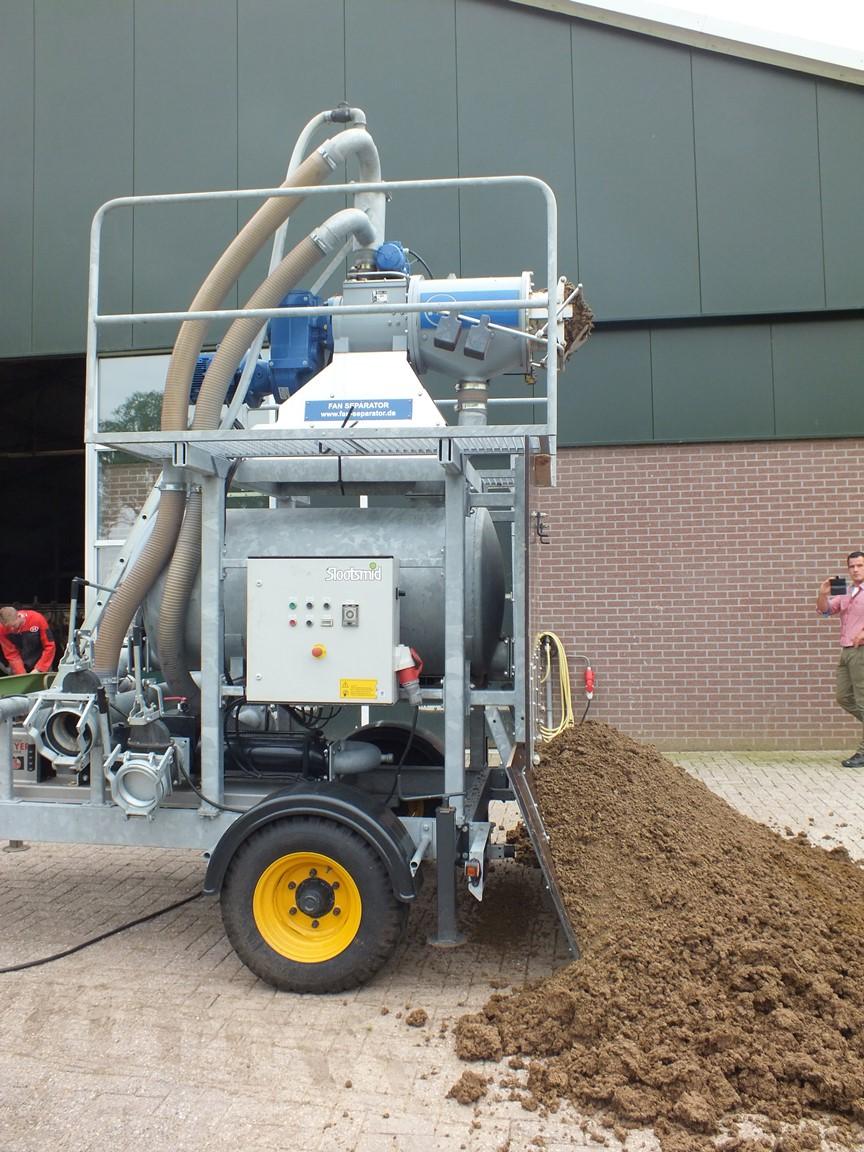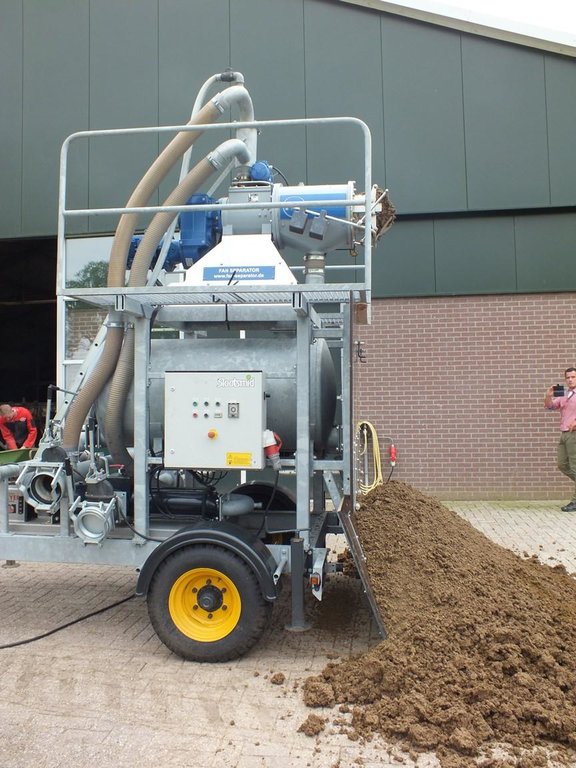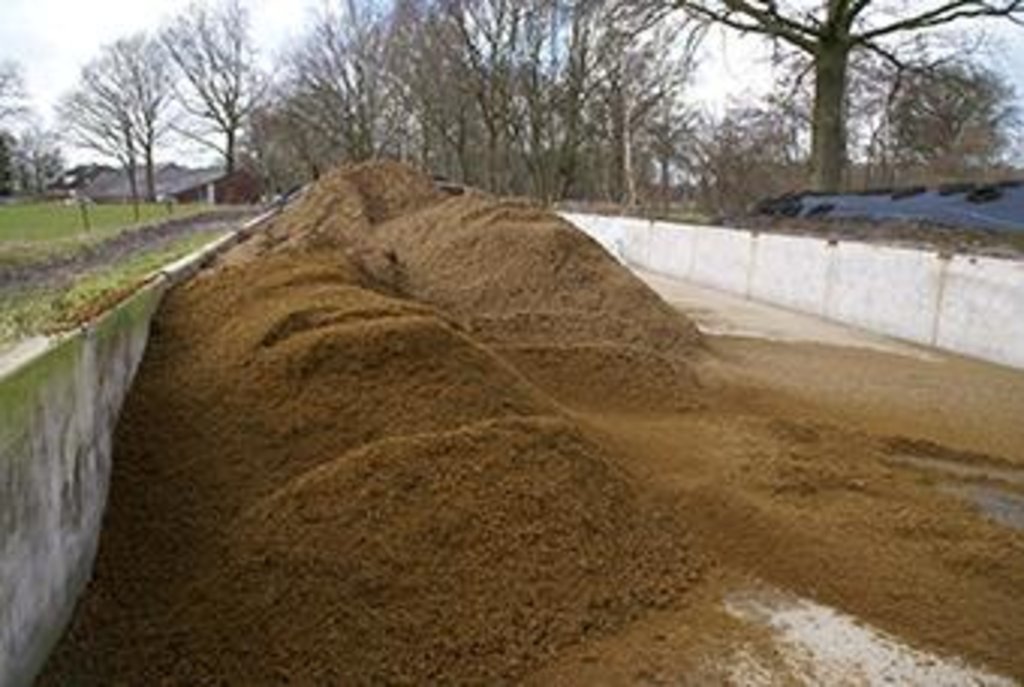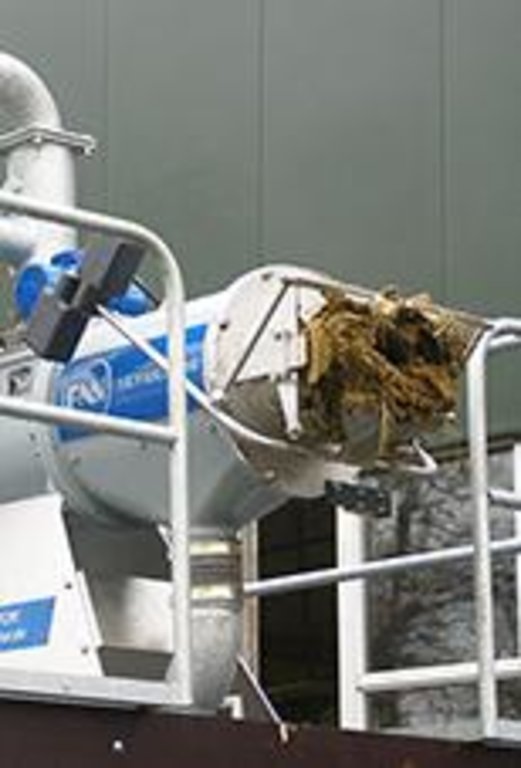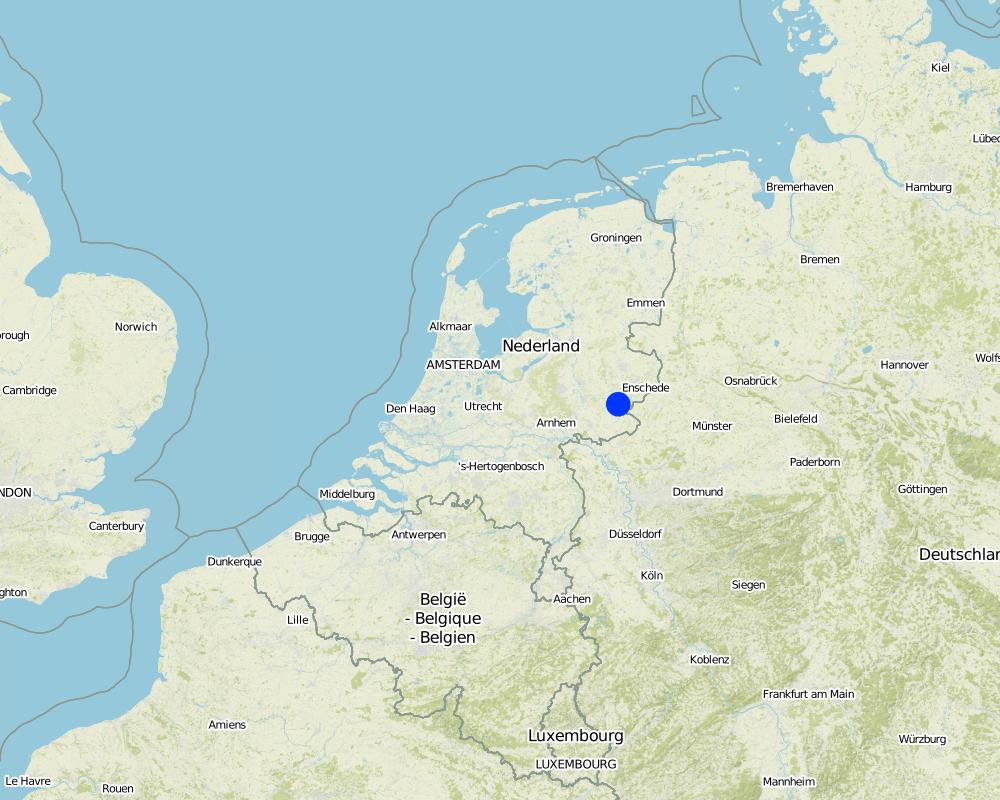Manure separation to better distribute organic matter at farm level [荷兰]
- 创建:
- 更新:
- 编制者: Simone Verzandvoort
- 编辑者: –
- 审查者: Fabian Ottiger, Alexandra Gavilano
Mestscheiding om organische stof op bedrijfsniveau beter te verdelen (NL)
technologies_1256 - 荷兰
查看章节
全部展开 全部收起1. 一般信息
1.2 参与该技术评估和文件编制的资源人员和机构的联系方式
SLM专业人员:
Smit Annemieke
Wageningen Environmental Research (Alterra)
荷兰
SLM专业人员:
Leever Henk
HOEDuurzaam
荷兰
SLM专业人员:
Rienks Willem
Rom3D
荷兰
有助于对技术进行记录/评估的项目名称(如相关)
Preventing and Remediating degradation of soils in Europe through Land Care (EU-RECARE )有助于对技术进行记录/评估的机构名称(如相关)
Hoe Duurzaam - 荷兰有助于对技术进行记录/评估的机构名称(如相关)
ROM3D - 荷兰有助于对技术进行记录/评估的机构名称(如相关)
Wageningen Environmental Research (Alterra) - 荷兰有助于对技术进行记录/评估的机构名称(如相关)
Provincie Gelderland - 荷兰有助于对技术进行记录/评估的机构名称(如相关)
Vitens - Laat Water Voor Je Werken - 荷兰1.3 关于使用通过WOCAT记录的数据的条件
编制者和关键资源人员接受有关使用通过WOCAT记录数据的条件。:
是
2. SLM技术的说明
2.1 技术简介
技术定义:
Separation of cow manure is a common practice on dairy farms in The Netherlands to improve the nutrient use efficiency.
2.2 技术的详细说明
说明:
Het primaire doel van mestscheiding is de productie van een dikke
fractie met hoge gehalten aan organische stof en mineralen en een laag vochtgehalte. Een dergelijke geconcentreerde
fosfaatrijke fractie is een waardevolle organische meststof en kan over grote afstand vervoerd worden. De
dunne waterige fractie, met daarin het grootste deel van de stikstof, kan op eigen grond of in de nabije omgeving als
meststof worden aangewend of verder worden gezuiverd tot loosbaar water.
Slurry manure is fed through a manure separator that separates much of the thick material from the liquid portion. These fractions differ in the proportion between P and N; the thick fraction contains relatively more P than the thin fraction.
The thick fraction is used on maize fields or as substrate in cow stables; the thin fraction, with the larger part of the nitrogen, can be used on other parts of the farm or is exported from the farm to be treated for discharge in the environment. Due to stricter regulations for the application of N and P to crop land and grassland, less manure may be applied to the land. If manure must be exported because the threshold for P is reached, this implies that also N is exported from the farm.
Purpose of the Technology: Slurry from livestock consists of more than 90% of water. The primary purpose of manure separation is to produce a thick fraction with high contents of organic matter and nutrients and a low moisture content. The thick fraction is a valuable fertiliser and can be transported over large distances. The thin fraction, with the larger part of the nitrogen, can be applied as fertiliser on the farm, on farmland in the proximity, or can be treated into a quality suitable for discharge in the environment or water drainage system.
Manure separation allows farmers to use organic matter from manure more efficiently at the farm level. Manure separation increases the efficiency of processing and using manure in 5 ways:
1. By concentrating phosphorus in the thick fraction the volume of manure to be exported can be decreased, and also the export of nitrogen from the farm.
2. Manure separation creates three types of manure (thick, thin and mixed), which allows for differentiated application to different fields and crops, and reductions on requirements for artificial fertiliser.
3. Manure separation decreases the volume of manure to be exported from farms, and therefore saves energy and transport costs.
4. The thick fraction can be stored in stacks, taking up less space.
5. The thick fraction can be used as substrate in stables, replacing costly sawdust.
Establishment / maintenance activities and inputs: Purchase a manure separator. Periodically feed your collected slurry manure through the separator and then apply the thick portion to your fields. Discard the liquid portion.
Natural / human environment: Dairy farming on sandy soils in the eastern part of The Netherlands. Stricter manure regulation originting from the Nitrates Directive sets a limit on the amounts of animal manure for farms on sandy and loess soils in the eastern and southern part of The Netherlands.
2.3 技术照片
2.5 已应用该技术的、本评估所涵盖的国家/地区/地点
国家:
荷兰
区域/州/省:
Gelderland
有关地点的进一步说明:
Haarlo - Oude Eibergen
具体说明该技术的分布:
- 均匀地分布在一个区域
如果不知道精确的区域,请注明大致覆盖的区域:
- < 0.1 平方千米(10 公顷)
注释:
The thick manure fraction is applied to corn fields. There is 240 ha of corn in the area amongst 44 farmers. Only 2 farmers are applying this technology.
Map
×2.6 实施日期
如果不知道确切的年份,请说明大概的日期:
- 不到10年前(最近)
2.7 技术介绍
详细说明该技术是如何引入的:
- 通过项目/外部干预
注释(项目类型等):
The land users's initiative was through the application for the project Healthy Sand by a group of farmers. During the Gezond Zand Project the group organised themselves in the Foundation HOEDuurzaam. The project ran from 2012-2014 and is followed by the new project BodemRijk.
The external initiative was from the drinking water company Vitens and the Province of Gelderland in the same period.
3. SLM技术的分类
3.2 应用该技术的当前土地利用类型

农田
- 一年一作
年作 - 具体指明作物:
- 谷物类 - 玉米
- 谷类 - 其他
- 饲料作物 - 草
- 根/块茎作物 - 土豆
每年的生长季节数:
- 1
具体说明:
Longest growing period in days: 250Longest growing period from month to month: March-November

牧场
集约放牧/饲料生产:
- 收割和携带/零放牧
- 改良牧场
注释:
Major cash crop annual cropping: Potatoes
Major food crop annual cropping: Maize, cereals
Major food crop perennial (non-woody) cropping: Grass
Major land use problems (compiler’s opinion): Decrease of soil organic matter content.
Major land use problems (land users’ perception): The group of farmers in the area expeience decreasing organic matter content in soil.
Cut-and-carry/ zero grazing: feeding in stables
Improved pasture: feeding in field
Livestock density: > 100 LU /km2
3.4 供水
注释:
Water supply: rainfed, mixed rainfed - irrigated, rainfed, mixed rainfed - irrigated
3.5 该技术所属的SLM组
- 土壤肥力综合管理
3.6 包含该技术的可持续土地管理措施

农艺措施
- A2:有机质/土壤肥力
注释:
Main measures: agronomic measures
Type of agronomic measures: manure / compost / residues
3.7 该技术强调的主要土地退化类型

化学性土壤退化
- Cn:肥力下降和有机质含量下降(非侵蚀所致)
注释:
Main type of degradation addressed: Cn: fertility decline and reduced organic matter content
Main causes of degradation: soil management (Intensive ploughing)
Secondary causes of degradation: crop management (annual, perennial, tree/shrub) (Intensive crop management)
3.8 防止、减少或恢复土地退化
具体数量名该技术与土地退化有关的目标:
- 修复/恢复严重退化的土地
注释:
Main goals: rehabilitation / reclamation of denuded land
4. 技术规范、实施活动、投入和成本
4.1 该技术的技术图纸
技术规范(与技术图纸相关):
Slurry manure is the influent placed into the separator. A drill-press pushes the slurry and pressure squeezes out the liquid portion (Liqour). The thick manure (cake) is pressed out the end. The screen holds the solid material in the drill press.
Location: not applicable. not applicable
Date: 13-01-2008
Technical knowledge required for field staff / advisors: moderate (The agricultural advisor should advise on options for application of the thick fraction of manure based on composition.)
Technical knowledge required for land users: moderate (Farmer has to calculate and strategize distribution of thick manure fractions and RDM(slurry) to reach balanced application rates and consider impact between fields.)
Technical knowledge required for technical advisor from machine company: moderate (Technical advisor should advise on type of manure separator (screw or roller) depending on the intended use of the thick and thin fractions.)
Main technical functions: increase in organic matter
Secondary technical functions: increase in nutrient availability (supply, recycling,…)
Manure / compost / residues
Material/ species: Thick fraction obtained by separation of manure from dairy cows.
Quantity/ density: 10 t/ha
Remarks: The thick fraction is applied separately from the slurry.
作者:
Extension, http://www.extension.org/pages/27470/solids-separation-in-swine-manure-handling-systems#.VU9uDk0cRoI
4.2 有关投入和成本计算的一般信息
其它/国家货币(具体说明):
Euro
如相关,注明美元与当地货币的汇率(例如1美元=79.9巴西雷亚尔):1美元=:
0.94
注明雇用劳工的每日平均工资成本:
255.70
4.3 技术建立活动
| 活动 | 时间(季度) | |
|---|---|---|
| 1. | Buy a seperator |
4.4 技术建立所需要的费用和投入
| 对投入进行具体说明 | 单位 | 数量 | 单位成本 | 每项投入的总成本 | 土地使用者承担的成本% | |
|---|---|---|---|---|---|---|
| 设备 | Seperator | Machine | 1.0 | 5320.0 | 5320.0 | |
| 技术建立所需总成本 | 5320.0 | |||||
| 技术建立总成本,美元 | 5659.57 | |||||
注释:
Life span of the seperator: 6 years
Number of parties sharing: 44
4.5 维护/经常性活动
| 活动 | 时间/频率 | |
|---|---|---|
| 1. | Operating separator | once per year |
| 2. | Applying both thick fraction manure and RDM manure | once per year |
4.6 维护/经常性活动所需要的费用和投入(每年)
| 对投入进行具体说明 | 单位 | 数量 | 单位成本 | 每项投入的总成本 | 土地使用者承担的成本% | |
|---|---|---|---|---|---|---|
| 劳动力 | Labour | ha | 1.0 | 127.68 | 127.68 | 100.0 |
| 劳动力 | Sampling manure | ha | 1.0 | 21.28 | 21.28 | 100.0 |
| 设备 | Machine use | ha | 1.0 | 308.56 | 308.56 | 100.0 |
| 设备 | rent of manure separator | h | 1.0 | 16.5 | 16.5 | 100.0 |
| 设备 | depreciation costs | m3 | 1.0 | 0.65 | 0.65 | |
| 设备 | maintenance | machine | 1.0 | 0.3 | 0.3 | |
| 设备 | Electricity | ha | 1.0 | 3.72 | 3.72 | 100.0 |
| 肥料和杀菌剂 | Extra Potassium | ha | 1.0 | 10.64 | 10.64 | 100.0 |
| 技术维护所需总成本 | 489.33 | |||||
| 技术维护总成本,美元 | 520.56 | |||||
注释:
Machinery/ tools: Separator, truck, loader, tractor
Cost of everything per hour was multiplied by totals and divided by hectares applied so costs per hectare are given. The establishment cost of the separator is the total unit. It was purchased by the farmer's foundation. It can not be given in a cost per hectare.
4.7 影响成本的最重要因素
描述影响成本的最决定性因素:
Labour. Equipment.
5. 自然和人文环境
5.1 气候
年降雨量
- < 250毫米
- 251-500毫米
- 501-750毫米
- 751-1,000毫米
- 1,001-1,500毫米
- 1,501-2,000毫米
- 2,001-3,000毫米
- 3,001-4,000毫米
- > 4,000毫米
有关降雨的规范/注释:
182 days of precipitation annually
农业气候带
- 半湿润
Thermal climate class: temperate. Mean monthly temperature varies between 2-17 °C ( LGP 240-269 days, mean monthly temperature varies between 2-17 °C)
5.2 地形
平均坡度:
- 水平(0-2%)
- 缓降(3-5%)
- 平缓(6-10%)
- 滚坡(11-15%)
- 崎岖(16-30%)
- 陡峭(31-60%)
- 非常陡峭(>60%)
地形:
- 高原/平原
- 山脊
- 山坡
- 山地斜坡
- 麓坡
- 谷底
垂直分布带:
- 0-100 m a.s.l.
- 101-500 m a.s.l.
- 501-1,000 m a.s.l.
- 1,001-1,500 m a.s.l.
- 1,501-2,000 m a.s.l.
- 2,001-2,500 m a.s.l.
- 2,501-3,000 m a.s.l.
- 3,001-4,000 m a.s.l.
- > 4,000 m a.s.l.
关于地形的注释和进一步规范:
Altitudinal zone: 0-100 m a.s.l. (up to 45 metres a.s.l.)
Slopes on average: Flat and gentle (only incidentally.)
5.3 土壤
平均土层深度:
- 非常浅(0-20厘米)
- 浅(21-50厘米)
- 中等深度(51-80厘米)
- 深(81-120厘米)
- 非常深(> 120厘米)
土壤质地(表土):
- 粗粒/轻(砂质)
- 中粒(壤土、粉土)
表土有机质:
- 高(>3%)
- 中(1-3%)
如有可能,附上完整的土壤描述或具体说明可用的信息,例如土壤类型、土壤酸碱度、阳离子交换能力、氮、盐度等。:
Soil depth on average: Deep (A and B horizons up till 40 cm in Gleyic Podzols and Umbric Gleysols (ca 75% of the area). Hardly any soil organic matter below 15 cm. Rooting depth is up to 80 cm.) and very deep (deep topsoils rich in organic matter in the Fimic Anthrosols (12% of the area).)
Soil texture is coarse/light (most soils have a sandy texture due to the substrate consisting of cover sands) and medium (Soils in former creek valleys contain loam (Umbric Gleysols))
Soil fertility is low (Most soils have a low fertility due to the sandy substrate (specifically the Gleyic Podzols, ca 40% of the area)) and very high (in Fimic Anthrosols originated due to application of farmyard manure since medieval times (12% of the area))
Topsoil organic matter is medium (the purpose of the technology is to increase soil organic matter at farm level)
Soil drainage/infiltration is good (deep groundwater table (H>40-80 cm; L>120 cm) in the sandy soils on thick substrate of cover sands (in 65% of the area)) and medium (shallow groundwater tables in the Umbric Gleysols (35% of the area).
Soil water storage capacity is medium (in the other soils, varying with the soil organic matter content) and very high (in the Fimic Anthrosols with high SOM in the topsoil.)
5.4 水资源可用性和质量
地下水位表:
< 5米
地表水的可用性:
中等
水质(未处理):
不良饮用水(需要处理)
关于水质和水量的注释和进一步规范:
Ground water table: <5m (in all soil types the highest level of the groundwater table during the year is <140 cm below the soil surface. The lowest level can be lower than 120 cm)
Availability of surface water is medium (From small rivers (De Berkel) and creeks)
Water quality (untreated) is poor drinking water (levels of the pesticides Bentazon and MCPP in the groundwater have incidentally exceeded the norms for drinking water production between 1985 and 2009)
5.5 生物多样性
物种多样性:
- 中等
关于生物多样性的注释和进一步规范:
Soil biodiversity is high in the Fimic Anthrolsols.
5.6 应用该技术的土地使用者的特征
生产系统的市场定位:
- 混合(生计/商业)
- 商业/市场
非农收入:
- 低于全部收入的10%
相对财富水平:
- 平均水平
个人或集体:
- 个人/家庭
机械化水平:
- 机械化/电动
性别:
- 男人
说明土地使用者的其他有关特征:
Land users applying the Technology are mainly common / average land users
Difference in the involvement of women and men: Most outdoor farm operations are completed by men. Women often have jobs outside the farm.
Population density: 10-50 persons/km2
Annual population growth: < 0.5%
100% of the land users are average wealthy and own 100% of the land.
Off-farm income specification: Some farmers are contractual workers. Wives of farmers often have a job, e.g. at the municipality or craft work. Farms do not provide B&B or educational services.
Market orientation of cropland production system is mixed ( Maize is completely used to feed cows (max 20% of the area is allowd under maize); other arable crops are sold to the market. Dairy production is commercial. )
Market orientation of grazing land production system is commercial/market (dairy farmers grow feed crops for their livestock)
5.7 应用该技术的土地使用者使用的平均土地面积
- < 0.5 公顷
- 0.5-1 公顷
- 1-2 公顷
- 2-5公顷
- 5-15公顷
- 15-50公顷
- 50-100公顷
- 100-500公顷
- 500-1,000公顷
- 1,000-10,000公顷
- > 10,000公顷
这被认为是小规模、中规模还是大规模的(参照当地实际情况)?:
- 中等规模的
注释:
Average area of land owned or leased by land users applying the Technology: 5-15 ha, 15-50 ha, 50-100 ha
Cropland per household: 15-50 ha (6 land owners (situation in 2014)) and 50-100 ha (15 land owners, situation in 2014)
Grazing land per household: 5-15 ha (average grassland is 7.8 ha per household)
5.8 土地所有权、土地使用权和水使用权
土地所有权:
- 个人,有命名
- Other forms of exploitation
土地使用权:
- 租赁
- 个人
注释:
Many fields have other forms of exploitation than individual ownership or lease.
5.9 进入服务和基础设施的通道
健康:
- 贫瘠
- 适度的
- 好
教育:
- 贫瘠
- 适度的
- 好
技术援助:
- 贫瘠
- 适度的
- 好
就业(例如非农):
- 贫瘠
- 适度的
- 好
市场:
- 贫瘠
- 适度的
- 好
能源:
- 贫瘠
- 适度的
- 好
道路和交通:
- 贫瘠
- 适度的
- 好
饮用水和卫生设施:
- 贫瘠
- 适度的
- 好
金融服务:
- 贫瘠
- 适度的
- 好
6. 影响和结论性说明
6.1 该技术的现场影响
社会经济效应
生产
作物生产
注释/具体说明:
expected, based on better targeted fertiliser application
水资源可用性和质量
灌溉用水需求
注释/具体说明:
expected due to increase of SOM
收入和成本
农业投入费用
注释/具体说明:
On artificial fertiliser (30-80% reduction on N fertiliser) and substrate for cow stables. But since the thick fraction contains less N per kg of P2O5 than the original mix, farners applying the thick fraction (for maize as described in this QT) may need to apply more articial N-fertilizer
农业收入
注释/具体说明:
Decreased costs for manure export from the farm: A smaller part of the total manure mix needs to be exported (ca 35% less N-export than without manure separation; 10-30% less net energy use)
其它社会经济效应
Ease of manure storage
注释/具体说明:
Thick fraction is less voluminous and can be stacked
Manure processing
注释/具体说明:
Thick fraction can be more easily stored and transported; thin fraction takes up less volume and does not need to be transported.
Energy use
SLM之前的数量:
4-7 GJ/ha
SLM之后的数量:
3-5 GJ/ha
注释/具体说明:
Energy use for manure transport, processing, digestion and fertiliser use
Expenses on machinery
注释/具体说明:
For farms with less than 1000-2000 tons of manure to be separated expenses on manure separation become larger than benefits. Such farms could better hire a mobile separator, as in the descirption of this SLM technology.
社会文化影响
Improved livelihoods and human well-being
注释/具体说明:
Dairy farmers have learned more about the importance of soil organic matter for their production systems, and about the consequences of soil and manure management on soil organic matter and other aspects of soil health. This learning was brought by the exchange of knowledge between farmers and experts, and between farmers themselves. Farmers also profited from services provided to them by the farmers' foundations: shared investments (e.g. in the manure separator) and support in the application for subsidies to finance the SLM measure.
生态影响
水循环/径流
水质
注释/具体说明:
expected: reduction in leaching of nitrate and phosphorus due to better targeted manuring to plant needs
土壤
土壤水分
注释/具体说明:
due to increased SOM
土壤有机物/地下C
注释/具体说明:
due to improved manure composition for crop growth and build-up of SOM
减少气候和灾害风险
碳和温室气体的排放
注释/具体说明:
due to better targeted fertiliser use to needs of crops and reduced use of artificial fertiliser (30-80% less supply of N-fertiliser required)
其它生态影响
Emission of NH3
SLM之前的数量:
18
SLM之后的数量:
20
注释/具体说明:
NH3 loss in kg/ha, for dairy farms with 1.75 cows/ha, manure prod of 255 kg N/haand other assumptions; model estimate
P2O5 surplus
SLM之前的数量:
1
SLM之后的数量:
4
注释/具体说明:
P2O5 surplus in kg/ha, same conditions
6.2 该技术的场外影响已经显现
地下水/河流污染
SLM之前的数量:
12.5
SLM之后的数量:
10.4
注释/具体说明:
Reduced leaching of nitrate from fields where manure is applied due to less surplus of N in thin fraction(NO3-N in groundwater in mg/lfor farm with 1.75 dairy cows/ha)
Energy use
SLM之前的数量:
4-7 GJ/ha
SLM之后的数量:
3-5 GJ/ha
注释/具体说明:
Energy use for transport of manure from farms, processing, digestion, fertiliser use
6.3 技术对渐变气候以及与气候相关的极端情况/灾害的暴露和敏感性(土地使用者认为的极端情况/灾害)
渐变气候
渐变气候
| 季节 | 增加或减少 | 该技术是如何应对的? | |
|---|---|---|---|
| 年温度 | 增加 | 好 |
气候有关的极端情况(灾害)
气象灾害
| 该技术是如何应对的? | |
|---|---|
| 局地暴雨 | 好 |
| 局地风暴 | 好 |
气候灾害
| 该技术是如何应对的? | |
|---|---|
| 干旱 | 好 |
水文灾害
| 该技术是如何应对的? | |
|---|---|
| 比较和缓的(河道)洪水 | 好 |
其他气候相关的后果
其他气候相关的后果
| 该技术是如何应对的? | |
|---|---|
| 缩短生长期 | 好 |
注释:
The technology is almost independent on environmental change, since it depends on the availability of manure. It is strongly dependent on the farming system (supply of manure and possibility to apply the separated fractions on farm).
6.4 成本效益分析
注释:
There is no evidence yet on economic and agronomic effects of using the manure separator in the area, so the land user's perspective cannot be given. Assessments of costs, effects and energy use based on modelling are available in the literature for dairy and arable farming in the NL in Schroder et al. (2009). These reveal that for farms with 1.75 to 2.18 dairy cows/ha and under conditions of manure production and application and manure regulations for this part of The Netherlands, the required export of N-manure could decrease by 35%, required N-fertiliser by 30-80%, and net energy use by 10-30%.
6.5 技术采用
如若可行,进行量化(住户数量和/或覆盖面积):
2
注释:
100% of land user families have adopted the Technology with external material support
2 land user families have adopted the Technology with external material support
Comments on acceptance with external material support: The Foundation HOEDuurzaam purchased the manure separator. Farmers can use the machine for 15 euros/hour, and can apply for a subsidy from the Province when applying the technology. Two farmers were actively using the machine in 2014.
Comments on adoption trend: We do not have information on how many farmers were using the manure separator in 2015. This information will become available in 2016.
6.7 该技术的优点/长处/机会
| 土地使用者眼中的长处/优势/机会 |
|---|
|
increases soil organic matter How can they be sustained / enhanced? continued application of the measure and subsidy for maintenance of the manure separator by the Foundation; support to farmers in calculating parameters for manure separation specific for their farm (type of manure, concentrations, fields to apply to, livestock intensity) |
| energy saving and reduced loss of N while maintaining equal levels of crop production |
| 编制者或其他关键资源人员认为的长处/优势/机会 |
|---|
|
increases soil organic matter How can they be sustained / enhanced? continued application of the measure and subsidy for maintenance of the manure separator by the Foundation; support to farmers in calculating parameters for manure separation specific for their farm (type of manure, concentrations, fields to apply to, livestock intensity) |
| increases available soil moisture |
| reduces leaching of nitrate to the groundwater |
| reduces energy use for manure handling and transport |
6.8 技术的弱点/缺点/风险及其克服方法
| 编制者或其他关键资源人员认为的弱点/缺点/风险 | 如何克服它们? |
|---|---|
| there is still little experience with manure separation and there are many uncertainties relating to separation efficiency and financial aspects |
7. 参考和链接
7.1 信息的方法/来源
7.3 链接到网络上的相关信息
标题/说明:
Mestscheiding: relaties tussen techniek, kosten, milieu en landbouwkundige waarde - Jaap Schröder, Fridtjof de Buisonjé, Gerrit Kasper, Nico Verdoes & Koos Verloop, Plant and Animal Sciences Groups Wageningen UR, 2009.
URL:
http://edepot.wur.nl/50884
链接和模块
全部展开 全部收起链接
无链接
模块
无模块


